1997 MERCEDES-BENZ ML350 light
[x] Cancel search: lightPage 2672 of 4133
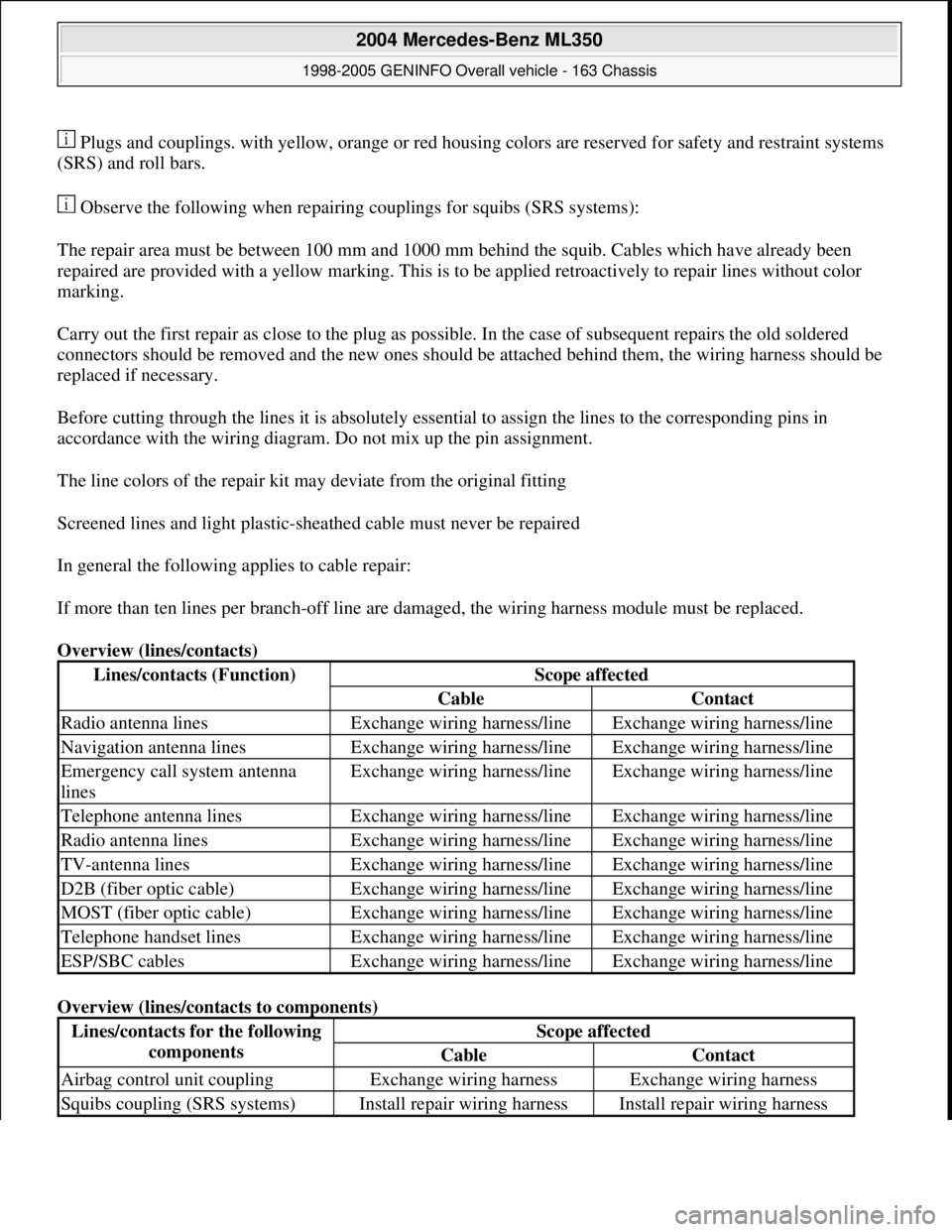
Plugs and couplings. with yellow, orange or red housing colors are reserved for safety and restraint systems
(SRS) and roll bars.
Observe the following when repairing couplings for squibs (SRS systems):
The repair area must be between 100 mm and 1000 mm behind the squib. Cables which have already been
repaired are provided with a yellow marking. This is to be applied retroactively to repair lines without color
marking.
Carry out the first repair as close to the plug as possible. In the case of subsequent repairs the old soldered
connectors should be removed and the new ones should be attached behind them, the wiring harness should be
replaced if necessary.
Before cutting through the lines it is absolutely essential to assign the lines to the corresponding pins in
accordance with the wiring diagram. Do not mix up the pin assignment.
The line colors of the repair kit may deviate from the original fitting
Screened lines and light plastic-sheathed cable must never be repaired
In general the following applies to cable repair:
If more than ten lines per branch-off line are damaged, the wiring harness module must be replaced.
Overview (lines/contacts)
Overview (lines/contacts to components)
Lines/contacts (Function)Scope affected
CableContact
Radio antenna linesExchange wiring harness/lineExchange wiring harness/line
Navigation antenna linesExchange wiring harness/lineExchange wiring harness/line
Emergency call system antenna
linesExchange wiring harness/lineExchange wiring harness/line
Telephone antenna linesExchange wiring harness/lineExchange wiring harness/line
Radio antenna linesExchange wiring harness/lineExchange wiring harness/line
TV-antenna linesExchange wiring harness/lineExchange wiring harness/line
D2B (fiber optic cable)Exchange wiring harness/lineExchange wiring harness/line
MOST (fiber optic cable)Exchange wiring harness/lineExchange wiring harness/line
Telephone handset linesExchange wiring harness/lineExchange wiring harness/line
ESP/SBC cablesExchange wiring harness/lineExchange wiring harness/line
Lines/contacts for the following
componentsScope affected
CableContact
Airbag control unit couplingExchange wiring harnessExchange wiring harness
Squibs coupling (SRS systems)Install repair wiring harnessInstall repair wiring harness
2004 Mercedes-Benz ML350
1998-2005 GENINFO Overall vehicle - 163 Chassis
me
Saturday, October 02, 2010 3:47:44 PMPage 27 © 2006 Mitchell Repair Information Company, LLC.
Page 2857 of 4133
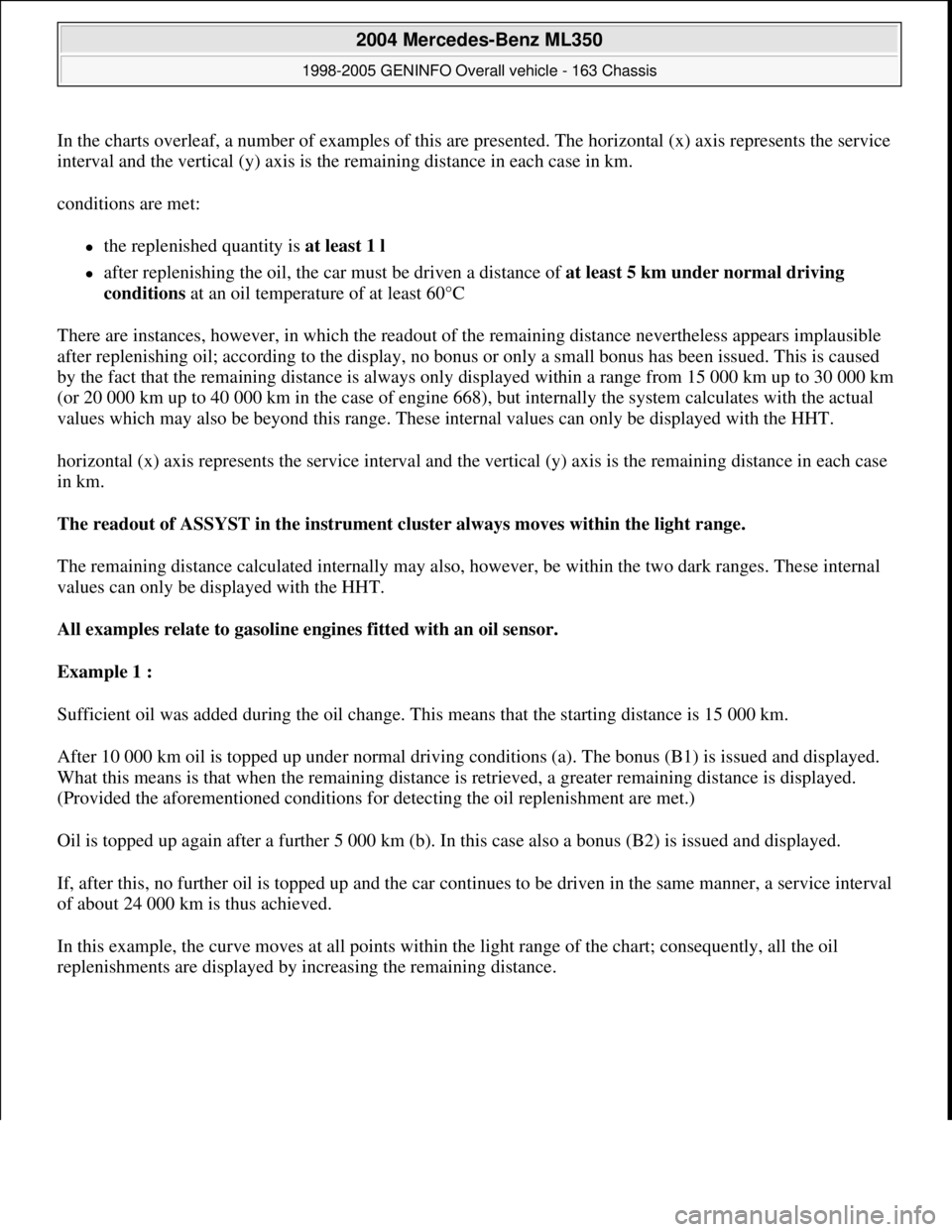
In the charts overleaf, a number of examples of this are presented. The horizontal (x) axis represents the service
interval and the vertical (y) axis is the remaining distance in each case in km.
conditions are met:
the replenished quantity is at least 1 l
after replenishing the oil, the car must be driven a distance of at least 5 km under normal driving
conditions at an oil temperature of at least 60°C
There are instances, however, in which the readout of the remaining distance nevertheless appears implausible
after replenishing oil; according to the display, no bonus or only a small bonus has been issued. This is caused
by the fact that the remaining distance is always only displayed within a range from 15 000 km up to 30 000 km
(or 20 000 km up to 40 000 km in the case of engine 668), but internally the system calculates with the actual
values which may also be beyond this range. These internal values can only be displayed with the HHT.
horizontal (x) axis represents the service interval and the vertical (y) axis is the remaining distance in each case
in km.
The readout of ASSYST in the instrument cluster always moves within the light range.
The remaining distance calculated internally may also, however, be within the two dark ranges. These internal
values can only be displayed with the HHT.
All examples relate to gasoline engines fitted with an oil sensor.
Example 1 :
Sufficient oil was added during the oil change. This means that the starting distance is 15 000 km.
After 10 000 km oil is topped up under normal driving conditions (a). The bonus (B1) is issued and displayed.
What this means is that when the remaining distance is retrieved, a greater remaining distance is displayed.
(Provided the aforementioned conditions for detecting the oil replenishment are met.)
Oil is topped up again after a further 5 000 km (b). In this case also a bonus (B2) is issued and displayed.
If, after this, no further oil is topped up and the car continues to be driven in the same manner, a service interval
of about 24 000 km is thus achieved.
In this example, the curve moves at all points within the light range of the chart; consequently, all the oil
replenishments are displayed by increasing the remaining distance.
2004 Mercedes-Benz ML350
1998-2005 GENINFO Overall vehicle - 163 Chassis
me
Saturday, October 02, 2010 3:47:47 PMPage 212 © 2006 Mitchell Repair Information Company, LLC.
Page 2858 of 4133
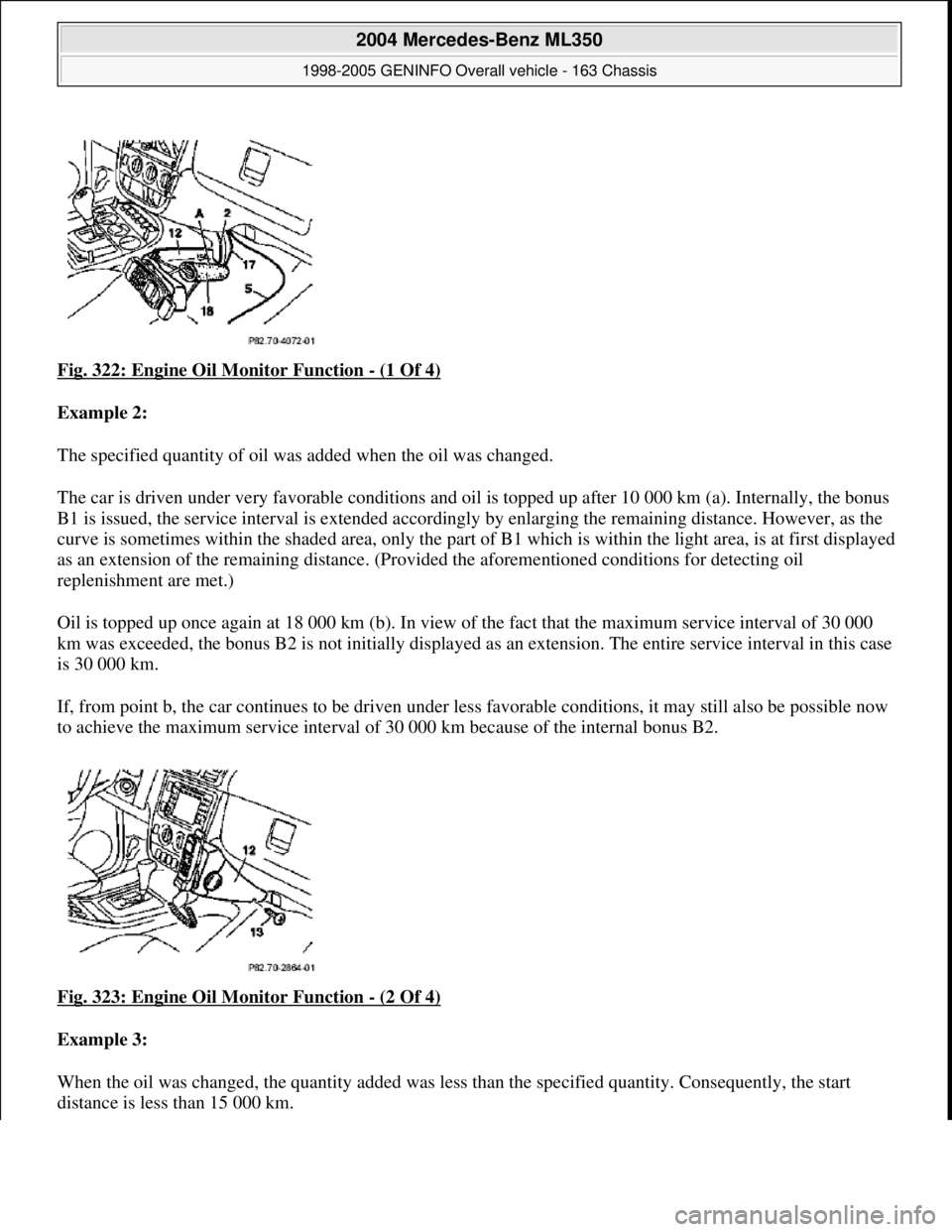
Fig. 322: Engine Oil Monitor Function - (1 Of 4)
Example 2:
The specified quantity of oil was added when the oil was changed.
The car is driven under very favorable conditions and oil is topped up after 10 000 km (a). Internally, the bonus
B1 is issued, the service interval is extended accordi ngly by enlarging the remaining distance. However, as the
curve is sometimes within the shaded ar ea, only the part of B1 which is within the light area, is at first displayed
as an extension of the remaining distance. (Provi ded the aforementioned conditions for detecting oil
replenishment are met.)
Oil is topped up once again at 18 000 km (b ). In view of the fact that the maximum service interval of 30 000
km was exceeded, the bonus B2 is not initially displayed as an extension. Th e entire service interval in this case
is 30 000 km.
If, from point b, the car continues to be driven under less favorable conditions , it may still also be possible now
to achieve the maximum service interval of 30 000 km because of the internal bonus B2.
Fig. 323: Engine Oil Monitor Function
- (2 Of 4)
Example 3:
When the oil was changed, the quantity added was less than the specified quantity. Consequently, the start
distance is less than 15 000 km.
2004 Mercedes-Benz ML350
1998-2005 GENINFO Overall vehicle - 163 Chassis
me
Saturday, October 02, 2010 3:47:47 PMPage 213 © 2006 Mitchell Repair Information Company, LLC.
Page 2859 of 4133

If oil is now topped up after 5 000 km (a), the remaining distance displayed is not extended as the curve is
within the shaded area. The bonus B1 is nevertheless added internally and results in an extension of the service
interval to slightly more than 15 000 km - provided the driving conditions remain the same or are more
favorable.
(The service interval of 15 000 km is always reached, however, even if the internal value were less.)
Fig. 324: Engine Oil Monitor Function
- (3 Of 4)
Example 4:
Oil has been topped up after 5 000 km under unfavorable driving conditions (a) and the oil replenishment
(bonus B1) detected internally. We now have two cases to consider:
If the car continues to be driven under the same conditions (unbroken line), the remaining distance
displayed is not extended as the curve is within the shaded area.
The service interval in this case is nevertheless 15 000 km although the internal value is less. (The
remaining distance displayed can always only be within the light area.)
If the car continues to be operated under more favorable conditions (broken line), the value of the internal
remaining distance slowly moves into the light area. Consequently, the service interval may be greater
than 15 000 km.
2004 Mercedes-Benz ML350
1998-2005 GENINFO Overall vehicle - 163 Chassis
me
Saturday, October 02, 2010 3:47:47 PMPage 214 © 2006 Mitchell Repair Information Company, LLC.
Page 2865 of 4133
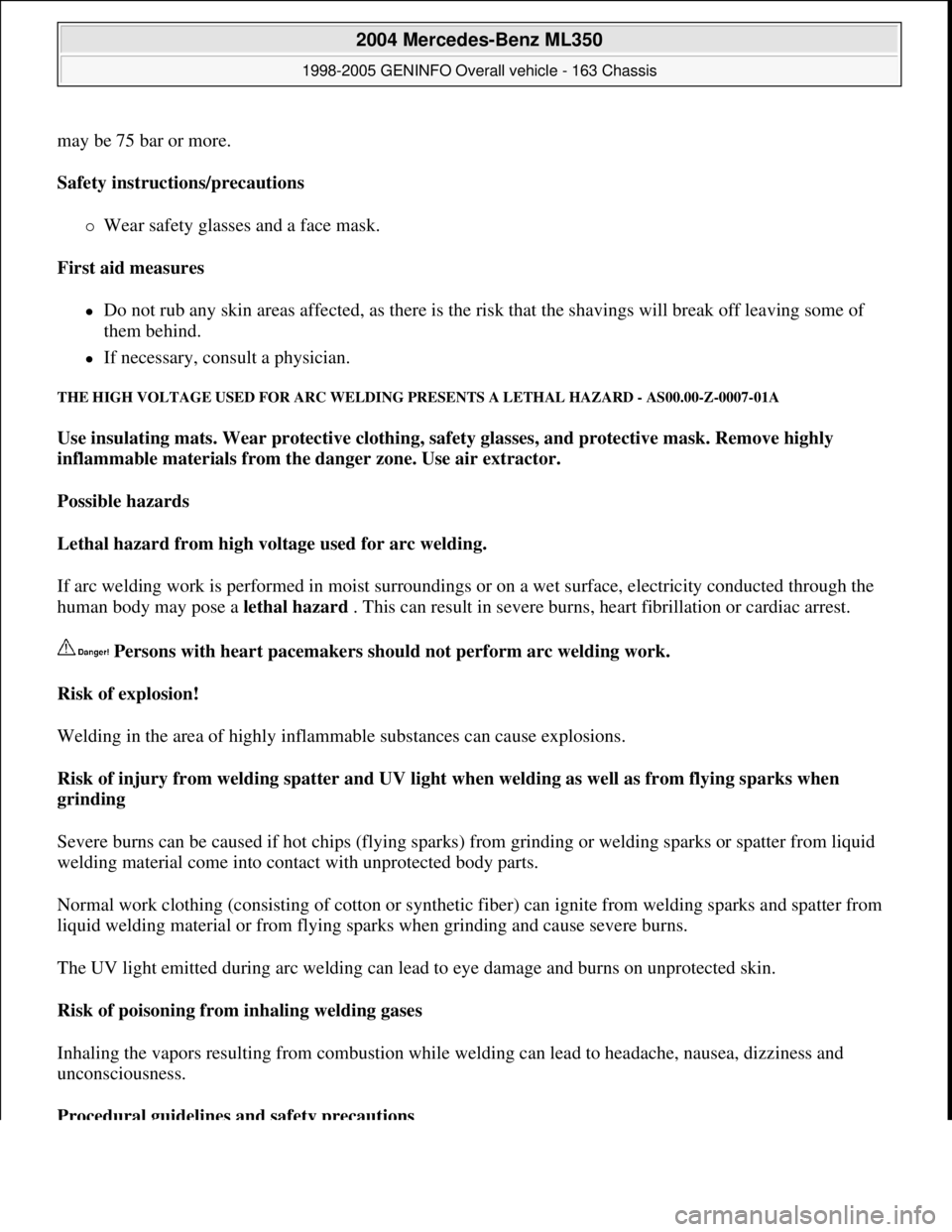
may be 75 bar or more.
Safety instructions/precautions
Wear safety glasses and a face mask.
First aid measures
Do not rub any skin areas affected, as there is the risk that the shavings will break off leaving some of
them behind.
If necessary, consult a physician.
THE HIGH VOLTAGE USED FOR ARC WELDING PRESENTS A LETHAL HAZARD - AS00.00-Z-0007-01A
Use insulating mats. Wear protective clothing, safety glasses, and protective mask. Remove highly
inflammable materials from the danger zone. Use air extractor.
Possible hazards
Lethal hazard from high voltage used for arc welding.
If arc welding work is performed in moist surroundings or on a wet surface, electricity conducted through the
human body may pose a lethal hazard . This can result in severe burns, heart fibrillation or cardiac arrest.
Persons with heart pacemakers should not perform arc welding work.
Risk of explosion!
Welding in the area of highly inflammable substances can cause explosions.
Risk of injury from welding spatter and UV light when welding as well as from flying sparks when
grinding
Severe burns can be caused if hot chips (flying sparks) from grinding or welding sparks or spatter from liquid
welding material come into contact with unprotected body parts.
Normal work clothing (consisting of cotton or synthetic fiber) can ignite from welding sparks and spatter from
liquid welding material or from flying sparks when grinding and cause severe burns.
The UV light emitted during arc welding can lead to eye damage and burns on unprotected skin.
Risk of poisoning from inhaling welding gases
Inhaling the vapors resulting from combustion while welding can lead to headache, nausea, dizziness and
unconsciousness.
Procedural guidelines and safety precautions
2004 Mercedes-Benz ML350
1998-2005 GENINFO Overall vehicle - 163 Chassis
me
Saturday, October 02, 2010 3:47:47 PMPage 220 © 2006 Mitchell Repair Information Company, LLC.
Page 2870 of 4133

Ensure sufficient ventilation, especially in the case of central hydraulic fluid.
Ensure that only authorized persons have access to hydraulic fluid.
Immediately seal disconnected leads and hoses, and the connections to the assemblies, with blind plugs.
Wear protective gloves, protective clothing and eye protection.
If protective gloves cannot be worn, the following points must be noted:
Only expose skin to hydraulic fluid for as brief a period as possible; in the event of contact with skin,
clean skin with soap and water.
In the event of contact with clothing, replace clothing as rapidly as possible.
First-aid measures
Have the person affected drink plenty of water with activated charcoal additive.
After swallowing large volumes, seek the attention of a physician.
If hydraulic fluid gets into the eyes, immediately rinse the eyes with plenty of clean water/eye rinsing
bottle.
In the event of injuries to the skin or eyes due to a jet of hydraulic fluid, immediately seek the attention of
a physician.
RISK OF INJURY. RUBBER MOUNTS AND BEARING PARTS CAN SUDDENLY COME LOOSE DURING
INSTALLATION/REMOVAL AND SHOOT WILDLY THROUGH THE AIR. - AS00.00-Z-0014-01A
Shield hazard area with suitable catch device (basket, grate box). Also ensure that no unauthorized
persons are present in the hazard area.
Risk of injury
When installing and removing tight transverse control arm mounts, the rubber mounts can be put under
extremely high tension. If one of the mounts is released suddenly it can shoot out of the installation bore hitting
and injuring anyone in the immediate area.
Safety precautions/instructions
When pressing parts in and out ensure that no one is in the immediate vicinity and therefore in the hazard
area except for the person performing the work.
Also secure the pressing point (hazard area) with a suitable catch device (basket, grate box).
When pressing out loosen mount by tapping a number of times with a hammer. Press out in a number of
intervals relieving the pressure in between.
RISK OF EXPLOSION FROM PRESSURIZED SPRAY CANS - AS00.00-Z-0015-01A
Protect cans from direct sunlight and temperatures above 50°C
2004 Mercedes-Benz ML350
1998-2005 GENINFO Overall vehicle - 163 Chassis
me
Saturday, October 02, 2010 3:47:48 PMPage 225 © 2006 Mitchell Repair Information Company, LLC.
Page 2871 of 4133

Risk of explosion
Spray cans (engine compartment preservative, paints, etc.) are pressurized and can explode when heated up to
above 50°C.
Safety instructions/precautions
Protect cans from direct sunlight and temperatures above 50°C. Do not drill or burn the can after use.
Only use in well ventilated areas, wear respiratory protection if necessary.
RISK OF POISONING & RISK OF INJURY - AS00.00-Z-0016-01A
Wear respiratory protection, protective gloves and safety glasses. Only pour glue into suitable and
appropriately marked containers.
Potential risks
Risk of poisoning
When glue vapors are inhaled , the respiratory system could be damaged because even small amounts of the
substances contained in some types of glues can attack the mucous membranes.
Swallowing glue can cause poisoning symptoms such as headaches, dizziness, cramps, stomach aches,
vomiting, respiratory paralysis and unconsciousness. Moreover, irritation may occur to the respiratory paths and
eyes.
Risk of injury
Most adhesives can glue limbs and eyelids as well as cause severe irritation to skin and eyes.
Safety precautions/instructions
Before applying adhesives, ensure that you have complied with all use and safety instructions; obtain the
safety data sheet from the manufacturer if required.
Perform gluing work only in well ventilated rooms.
No fire, sparks, open flames or smoking.
Wear protective gloves and eye protection, if necessary respiratory protection and protective clothing.
Do not fill glue into beverage cups
Store glue where it is not accessible for unauthorized persons.
First aid measures
Eye contact
Immediately rinse eyes thoroughly with running, lukewarm water and contact a physician.
2004 Mercedes-Benz ML350
1998-2005 GENINFO Overall vehicle - 163 Chassis
me
Saturday, October 02, 2010 3:47:48 PMPage 226 © 2006 Mitchell Repair Information Company, LLC.
Page 2877 of 4133
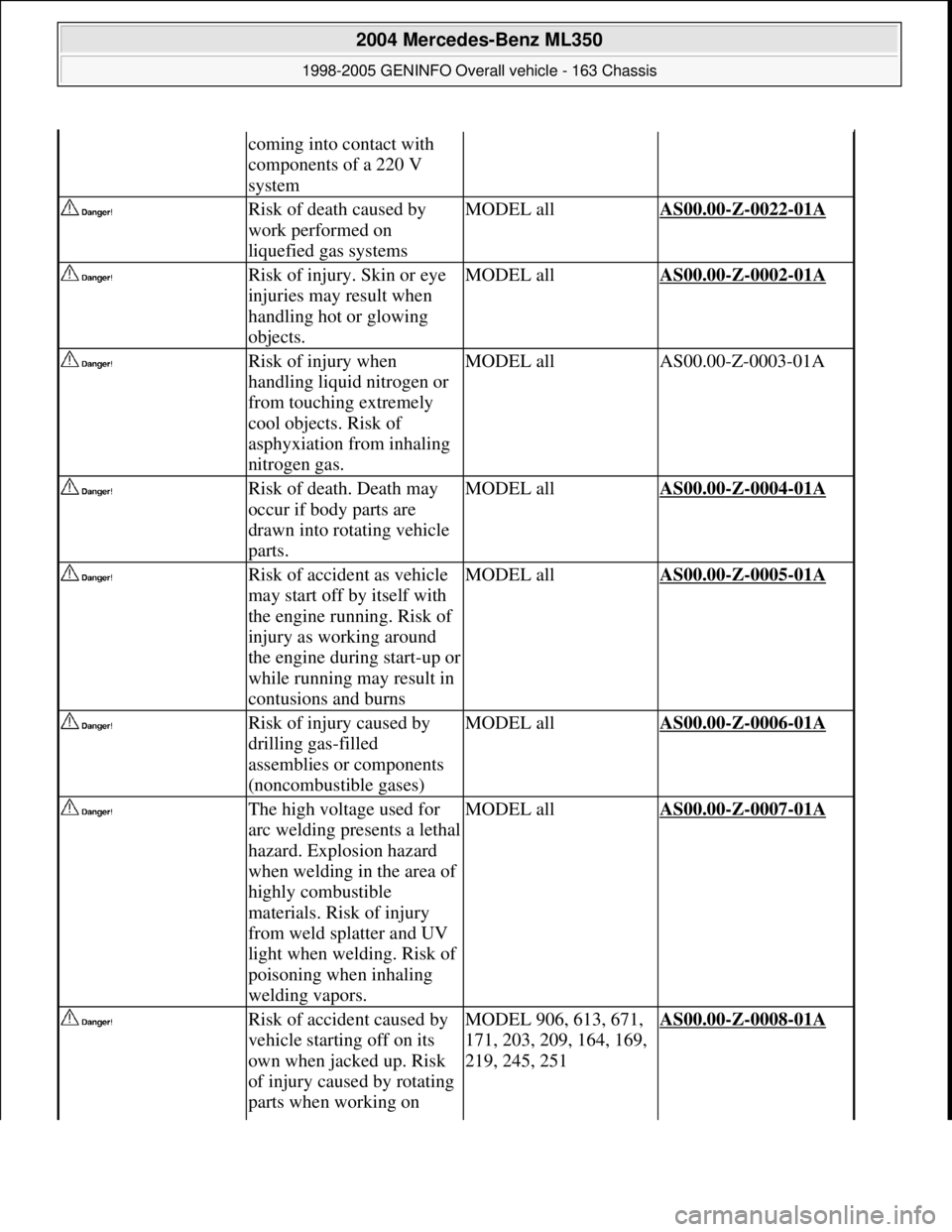
coming into contact with
components of a 220 V
system
Risk of death caused by
work performed on
liquefied gas systemsMODEL allAS00.00-Z-0022-01A
Risk of injury. Skin or eye
injuries may result when
handling hot or glowing
objects.MODEL allAS00.00-Z-0002-01A
Risk of injury when
handling liquid nitrogen or
from touching extremely
cool objects. Risk of
asphyxiation from inhaling
nitrogen gas.MODEL allAS00.00-Z-0003-01A
Risk of death. Death may
occur if body parts are
drawn into rotating vehicle
parts.MODEL allAS00.00-Z-0004-01A
Risk of accident as vehicle
may start off by itself with
the engine running. Risk of
injury as working around
the engine during start-up or
while running may result in
contusions and burnsMODEL allAS00.00-Z-0005-01A
Risk of injury caused by
drilling gas-filled
assemblies or components
(noncombustible gases)MODEL allAS00.00-Z-0006-01A
The high voltage used for
arc welding presents a lethal
hazard. Explosion hazard
when welding in the area of
highly combustible
materials. Risk of injury
from weld splatter and UV
light when welding. Risk of
poisoning when inhaling
welding vapors.MODEL allAS00.00-Z-0007-01A
Risk of accident caused by
vehicle starting off on its
own when jacked up. Risk
of injury caused by rotating
parts when working on MODEL 906, 613, 671,
171, 203, 209, 164, 169,
219, 245, 251AS00.00-Z-0008-01A
2004 Mercedes-Benz ML350
1998-2005 GENINFO Overall vehicle - 163 Chassis
me
Saturday, October 02, 2010 3:47:48 PMPage 232 © 2006 Mitchell Repair Information Company, LLC.